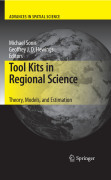
Tool kits in regional science: theory, models, and estimation
Sonis, M.
Hewings, G.J.
Regional Science is now more than 50 years old; in the last two decades, significant advances in methodology have occurred, spurred in large part by accessto computers. The range of analytical techniques now available is enormous; this books provides a sampling of the toolkit that is now at the disposal of analysts interested in understanding and interpreting the complexity of the spatial structure of sub- national economies. The set of tools ranges from the more traditional (input-output) to new developments in computable general equilibrium models, nonlinear dynamics, neural modelling and innovation. First collection of tools Advanced methods Excellent introduction to applied regioanl science Of value to younger scholars INDICE: M. Sonis: Introduction.- M. Sonis: Complex Socio-Economic Systems in Regional Science. Reconsideration of Theories of Linear Spatial Analysis.- M. Sonis; G.J.D. Hewings: New Developments in Input-Output Analysis. Fields ofInfluence of Changes, the Temporal Leontief Inverse and the Reconsideration of Classical Key Sector Analysis.- E. Haddad: Interregional Computable General Equilibrium Models.- T. Puu: Optimality versus Stability: Pattern Formation inSpatial Economics.- W. Weidlich: Urban and Hinterland Evolution under GrowingPopulation Pressure.- M. Sonis; D.S. Dendrinos: Socio-Spatial Dynamics and Discrete Non-Linear Probabilistic Chains.- M.M. Fischer: Principles of Neural Spatial Interaction Modeling.- D.A. Griffith: Quick but Not So Dirty ML Estimation of Spatial Autoregressive Models.- M. Sonis: Innovation Diffusion Theory: 100 Years of Development.- R. Capello; P. Nijkamp: Urban Economics at a Cross-road. Recent Theoretical and Methodological Directions and Future Challenges.- M. Sonis: Conclusion.
- ISBN: 978-3-642-00626-5
- Editorial: Springer
- Encuadernacion: Cartoné
- Páginas: 305
- Fecha Publicación: 01/06/2009
- Nº Volúmenes: 1
- Idioma: Inglés
